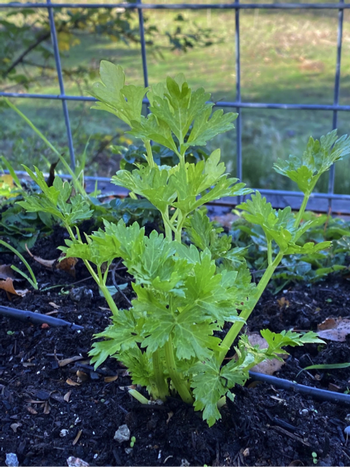Celery
-
Scientific NameApium graveolens
-
General InformationCelery is a cool weather crop with long fibrous stocks tapering to leaves. It is a hardy biennial grown as an annual. Celery is shallow rooted. It requires frequent irrigation and regular fertilization to produce a successful crop.
 Photo: by Tonya Koenker
Photo: by Tonya Koenker -
When to Plant
Plant celery seedlings when night temperatures are at least 49 degrees, usually in March and April. Celery grows best when temperatures are 60 to 65 degrees. Plant seedlings again in the late summer and early fall to be harvested before cold winter temperatures.
-
Planting
Plant celery seedlings in clay, clay loams, and loams that have good drainage and that are rich in nutrients. With adequate irrigation, lighter soils are also suitable. Plant seedlings nine inches apart with rows 14 inches apart.
Sow seeds indoors Sow seeds indoors in January and February for transplanting in March and April, and again in July for a late summer/fall planting. Germination should occur in approximately one week. Celery seeds are small and difficult to germinate. Transplant seedlings to a permanent location when about two inches tall. Harden off before planting outside by placing outdoors for several hours a day.
-
Soil Requirements
Celery needs nutrient rich soil with good drainage and high water-holding capacity.
-
Water Requirements
Celery needs a lot of water, approximately one to one and a half inches per week. In warm weather even more. Celery uses the most water in the month before harvest.
-
Fertilizing
Celery plants are heavy feeders. Amend soil at planting time and apply a liquid organic fertilizer, such as fish emulsion, every two to three weeks.
-
Pollination
Celery is usually harvested prior to pollination. When grown for seeds, it is pollinated by bees and other insects.
-
Harvesting
When celery is six to eight inches tall, outer stalks may be removed from the plant. Continue to remove stalks until the plant goes to seed or harvest the whole plant at any time. Cutting all stalks one-quarter into the root will allow the root to re-grow new stalks.
-
Storage
Celery can be stored in a plastic bag in the refrigerator at approximately 32 degrees with high humidity. Uncovered, celery may absorb odors from other vegetables. Celery may be also be blanched and frozen for use in cooking.
-
Good Varieties for Marin
Good varieties: ‘Golden Self Blanching’ ‘Utah' and their derivatives
Resistant to fusarium yellow: 'Command' 'Mission' 'Challenger' -
Helpful Tips
Tie stalks together with twine when they get floppy. Celery is a heavy feeder so fertilize regularly as suggested above. Practice crop rotation (celery is a member of the carrot family). Maintain consistent and adequate watering.
-
Common Problems
Flea beetles, slugs, snails, and earwigs. Also watch for aphids, leaf miners, and spider mites.
-
Pests- Diseases & More

